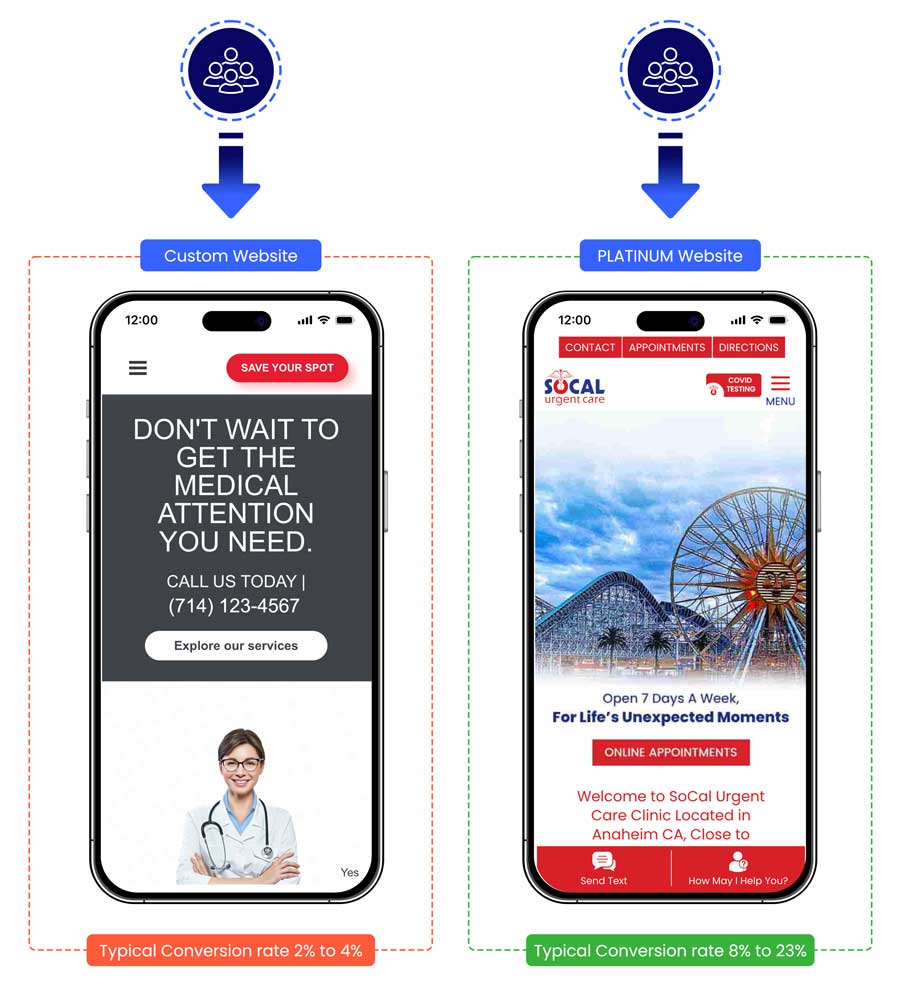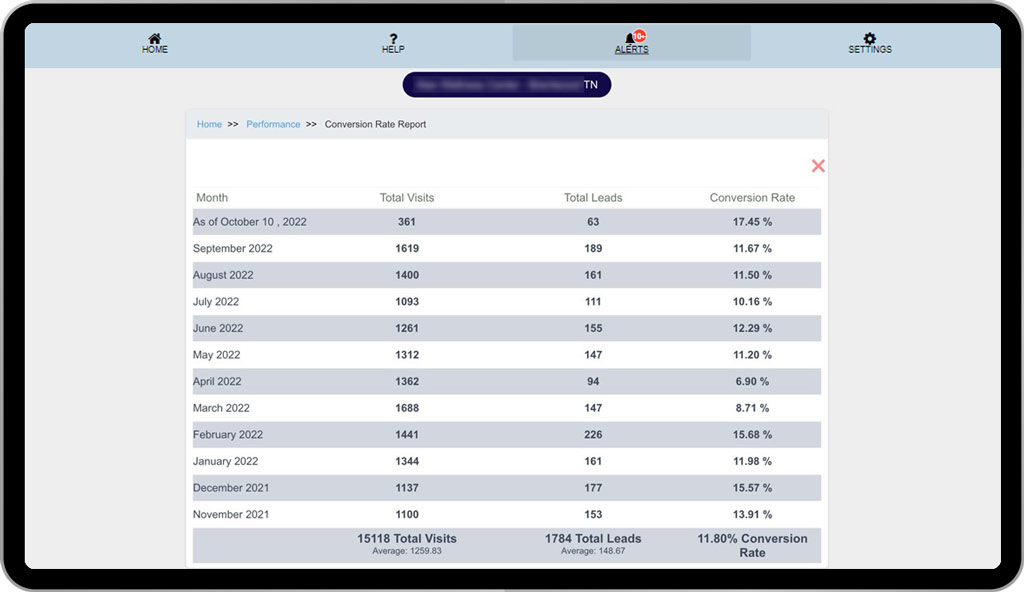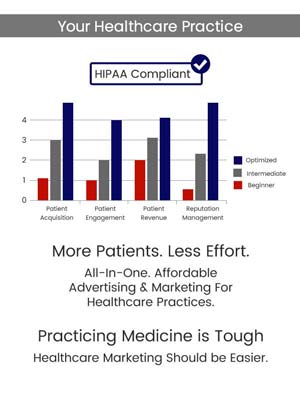A/B Tested medical & dental websites perform much better than a custom, non A/B tested websites. This is specifically important for your mobile website, as majority of the patients visit your website on a mobile device.
A/B testing of medical websites involves comparing two versions of a webpage (A and B) to see which performs better in terms of user engagement, conversion rates, or other key metrics. This data-driven approach helps healthcare organizations optimize their websites to improve user experience, drive better health outcomes, and achieve business goals. The best medical website design companies follow certain strategies, best practices, and data driven conversion techniques based on AI to produce excellent ROI for your medical or dental practice.

What is conversion rate of a medical or dental website?
Conversion rate is: 1f 100 potential patients visit your website, and 15 patients take a “conversion action” from your website, then your conversion rate is 15%. Most dental and medical websites have a conversion rate of 4.2%
Conversion rates of PLATINUM medical and dental websites are higher. Typically more than 10%
World’s best medical and dental websites are designed for high conversion rates and use AI based strategies to attract and convert new and existing patients. A/B testing on a doctor’s website involves comparing two versions of a webpage to see which performs better in terms of user engagement and conversions. This can help doctors optimize their websites for attracting and retaining patients. A/B testing, also known as split or bucket testing, is a method of comparing two versions of a website to determine which one performs better. In the context of medical websites, A/B testing can be used to optimize various aspects, including usability, navigation, and content, ultimately leading to a better user experience for patients seeking information or services.
Conversion rates of custom medical and dental websites are typically 4.2%
Typically, when medical and dental practices design, build and launch a new website, or improve or modify an existing medical or dental website, they do not go through the rigorous testing required for A/B testing for conversion rates. PatientGain reviewed 329 customers who contacted PatientGain. Not a single website from medical and dental practices had gone through A/B testing. About 94% of the medical and dental practices who contact PatientGain, have an existing website and about 6% of the medical and dental practices who contact PatientGain are new practices and trying to launch their website for their practice. A/B testing for conversions is difficult and expensive task. Hence 99% of the medical and dental practices never bother to go through the A/B testing for conversion rates. They are simply looking at visual aspects and launching. This results in websites that are pretty and attractive to the eye of the beholder, but typically will have a conversion rate of 2% to 4.2%.
Ethical considerations
Ethical considerations are important when conducting A/B tests on medical websites. These include ensuring consent and transparency regarding data collection, protecting user data and complying with regulations like HIPAA, avoiding a biased user experience, and designing tests that consider audience diversity to avoid biases.
A/B Tested conversion focused modern medical website design for doctors & dental practices. A/B tested websites perform anywhere from 23% to 90% better than randomly, custom designed websites. Our typical pricing is $799/mon to $1999/mon. A/B testing on medical websites allows healthcare organizations to optimize their online presence by comparing different versions of content or design elements to determine which resonates most with their target audience, leading to improved user engagement and potentially better patient outcomes.

Question: What are the most important qualities of a high conversion medical website design strategy?
There are dozens of factors, however the most important are:
1) Your practice’s website is your brand, it is your practice’s representation to the world. Branding, and how and what is presented on your website is the most import aspect. Clean and straightforward, easy to use, accessible, and packed with useful information (meaning content). Specifically focus on mobile version of your website, majority of your new patients visit you using a mobile device.
2) Content of the website is next most important part of your website. Content creates SEO and attracts patients and search engines. Focus on EAT algorithm for your healthcare website.
3) High conversion rates and focus on conversions is an extremely important part of your website.

Conversion rate optimization or CRO is an important part of your strategy. Building a new website is easy, optimizing it for best performance is difficult and tedious task. Every day thousands of doctors, physicians, chiropractors, surgeons, dentists, Med spas, pharma & medical practices struggle to fill their calendars. Every clinic has fixed costs, and if the calendar is not filled with paying patients, your clinic is operating at its full operational efficiency. PatientGain offers one time website setup pricing or monthly payments based on subscriptions, with no up front setup fees. See pricing here.


8 Important elements of your medical & dental website design:
1) It must be mobile optimized – Beyond mobile friendly.
2) It must be optimized for conversion and A/B tested.
3) Content must be fresh, relevant, on-topic, non-plagiarized. AI can be used to generate content, however, read this.
4) SEO Optimized for Google search engine, with proper technical structure of the website for each page.
5) Based on WordPress (or other proven platforms).
6) Secure HTTPS and HIPAA compliant and ADA adherent
7) Should promote and build your brand.
8) Must be pretty, attractive and branded with your own brand.
Why you need fast loading healthcare website?
Pages that loaded in less than 3 seconds had a highest conversion rate, top tier. We measured mobile patients only, as majority of the patients visit your medical and dental websites from a iPhone or Android phone.
For example: In the case study – Website of a medical practice using PatientGain.coms’ PLATINUM service, using A/B tested design has the following data: In the month of January – there are 3512 total sessions. Out of these 796 new patients contacted the practice indicating that they are “new” patients. Contacting a medical or a dental practice can happen using different channels. These channels can be 1) Phone call – most common 2) An appointment 3) Sending SMS/Text message 4) Contact form 5) Signing up for a news letter 6) Redeeming a promotion 7) Shopping on the ECommerce app.

Based on data, if a mobile website is slow, it will hurt your conversions and your business.
Pages that load in 3.1 to 4.0 seconds conversion rate dropped by 6 % from the top tier
Pages that load in 4.1 to 5.0 seconds conversion rate dropped by 19 % from the top tier
Pages that load in 5.1 to 6.0 seconds conversion rate dropped by 34 % from the top tier
Pages that load in 6.1 to 9.0 seconds conversion rate dropped by 61 % from the top tier
Pages that load in 9.1 to 12.0 seconds conversion rate dropped by 84 % from the top tier
More than 12 seconds, we did not calculate


What is A/B tested healthcare marketing website?
A/B testing is a common practice among software based marketing applications – in our case it is Medical marketing Websites. It is a way to compare two versions of medical marketing websites to arrive at a conclusion, based on data, not based on opinion, which of the 2 designs performs better. The test continues with multiple cycles until law of diminishing returns starts influencing a specific test. This is an ongoing process and never stops in the world on medical marketing and data driven results. For example, in our testing we found that it makes a big difference, where specific buttons are placed on the home page or a landing page of a medical marketing website. It also makes a big difference what the user sees first, specifically on a mobile device. For example the layout and user experience was kept the same in specific A/B tests, the only thing that was changed was how the images were formatted, branded VS non-branded generic images. There is a difference in results, based on hundreds and thousands or iterations of tests performed.


Does it make any difference where I place certain text, images, videos and buttons on my healthcare website ?
Yes, it makes a huge difference. For example,
1) Majority of the users will visit your website on a mobile device, not on a desktop
2) Majority of the users are right-handed
3) Majority of the users on a mobile device will scroll within first few seconds
4) Majority of the users on a mobile device will look for basic information first – like, a) what you offer b) your location(s) c) your services, d) and then contact information
5) If you do not have multi-channel conversion apps, you will get 5% to 8% less leads. Examples of multi-channel conversion apps are 1) ability for a potential patient to send you a HIPAA compliant text 2) Chat*Bot 3) tracking of new patient calls (with time stamp, origin, keyword data) 4) Appointment requests 5) Directions to the nearest location – without seeing you competitors on Google Maps
6) If your website loads slowly and it is cluttered, your conversion will drop
A/B tested websites perform anywhere from 23% to 90% better than randomly, custom designed websites

Just based on this data, you should place call to action, scrolling, buttons, text in specific places for the highest conversion. A/B testing is the science of data and human behavior as measured by data, not by your or my opinion.
Another important factor is how search engines read your website and assign a “quality score” based on your website that is readable by the search engines. For example you can have very fancy, gorgeous and elaborate website that looks very pleasing on a large 32 inch screen. However if it does not proper text, like Heading 1 (H1), Heading 2 (H2) , no useful text, just images, or the website loads very slowly, your conversion will go down. There is always a fine balance between aesthetics, branding, SEO text and conversion techniques. It is never going to perfect, however if your start with proven best practices, you will win. PatientGain’s GOLD and PLATINUM websites are based on these principles.
Is there an example for A/B testing of a healthcare website?
A/B testing scenario:
Duration is 4 months, over the period same amount of budget for online advertising on Google ads, and Facebook ads is allocated. Purposely, no changes were made to ads budget, ad copy was not changed, conversion settings for demographics and radius of targeted area was not changed. SEO – no new content was added, no new changes were made to the website content, no new SEO optimizations were applied, like off-page links, no new promotions were added, no updates to meta-tags, no changes were made to Email marketing frequency , no new apps were added to the website. No new social media posts were added to Google posts and Facebook Posts.
TEST A: The slider/top area of the targeted website has a nice video added – specifically there is a motion in the video. So when the user lands on the home page, person is drawn to the moving person. No other changes are made. 75 to 82 percentage of the patients are on mobile devices for this test. Same video, slides were setup for mobile, ipad and full website. Colors of the website remained the same.
TEST B: Video was replaced by a slide show, focused on services – specifically focus on benefits of each top services. 5 slides in the top area were added. First slide was general slide, each additional 4 slides had a CTA and link to each services page. No other changes were made to mobile, iPad or full computer user experience.
TEST C: 4 slides were added to the top of the website, focused on discounts and promotions – First slide was for capturing their attention, each additional 4 slides had a CTA and link to each promotion. No other changes were made to mobile, iPad or full computer user experience.
TEST D: Slides were replaced by a fixed image, but with scrolling text, focused on services – specifically focus on benefits of each top services. 8 services were added. No other changes were made to mobile, iPad or full computer user experience.
Results: Best results are from the test D – No movement in the top area. A simple branded image, Provider and staff welcoming patients, with background of the lobby of the practice. Overall conversions went up by 16%. Keeping it simple, minimum movement of slides, videos, in the top area is recommended for most medical websites. However, you should always do A/B testing on your own website for optimal results. We have also found that adding a video slows the website, which impacts conversions and SEO.
Use case example: Medical Spa using PatientGain PLATINUM service
In the table below, this data is from 12 months. Total of 15118 patients visited the website, from Google SEO, social media engagement, Email marketing and direct sources. From 15118 patients, 1784 new leads were generated. This means the conversion rate is 11.8 percentage of this website. Compare this to average conversion rates here.


Additional tests on multiple medical sites show the similar results. These tests were on multiple areas of US customers. All of them are medical websites, medspas, dental, and other medical disciplines. .
PatientGain.com’s web sites are A/B Tested to provide ROI (Return On Investment) for your medical marketing dollars.
PatientGain.com has run thousands of online campaigns for patient acquisition and patient engagement for medical clinics with typical patient acquisition costs anywhere from $8 to $27 per new patient in most US areas. Cloud based HIPAA compliant software is simple to use and easy to manage.




Medical Marketing Based On ROI
In world of data driven strategy also known as evidence based marketing or ROI based strategy, the computer scientists start with a known hypothesis (A) and compare with it with a variation (B) to see if the B setup produces better results.
This process is also called Split-Run tests. It is a derived from the field of statistics where statisticians (these days also known as data scientists/statisticians). When applied to Websites, PatientGain.com tests different variations of websites and calculates the results based on patient behavior and eventually a conversion from the website. This constant variations and testing produces results from actual patients and helps us produce best conversion website design for doctors.
For example, in case of certain practice areas, we discovered that 82 percent of the patients are visiting a website from mobile phones, rather than laptops, i-Pads and full computers, we placed “click-to-dial” at the proximity of a user’s fingers to make it easier to dial the clinic’s number. We saw 13% better conversion. There are hundreds of detailed analysis is performed to achieve optimal results.
In a 2nd example by placing a clinic’s services with highest margins close to the top of a page, we saw 4% increase in conversion for higher margin procedures.
There is a lot more that goes into creating optimal websites for doctors and healthcare practices.
Medical Marketing Conversion Websites are different than informational websites. Here are 8 examples of characteristics for medical marketing conversion websites
Your Medical Marketing Conversion Websites should:
No 1. Your medical marketing conversion website should have useful information for a patient visitor to easily contact you multiple ways. This includes
a. Click to Dial – Phone with tracking of calls
b. Fill out an Appointment Request
c. Send a SMS/Text
d. Find Directions
e. Find Medical Services
f. Send Secure Message to Medical Provider
g. Medical Chat*Bot to capture leads and provide useful information to a potential patient
No 2. Intelligence so Information is captured securely in a HIPAA Compliant database
No 3. Tracking software so source of your leads is captured so you can easily measure the ROI of each advertising medium
No 4. Promotions and Offers should be included predominantly
No 5. Tracking of Phone calls is very important
No 6. Ability to respond automatically ( Auto-Responders ) should be built into your medical marketing conversion website
No 7. A/B Tested layout for best possible patient experience and results
No 8. Your medical marketing conversion website should not take the user away from your primary focus. For example, if your strategy is to capture patient information from a landing page, keep it simple and to-the-point. Do not offer any other offers so the patient is tempted to click on another area and leave your website.
PatientGain examples demonstrating the significance of a well-optimized website:
- Dental Practice: A general dental practice in a competitive area achieved an 18.74% conversion rate, generating 675 new patient leads from 3,601 visitors in a single month.
- Medical Spa: A medical spa in California attained a 15.21% conversion rate, resulting in 200 new patient leads from 1,315 visitors in one month.
These examples highlight how a strategically designed and optimized website can significantly enhance patient acquisition and practice growth.
Conclusion
In summary, focusing on website conversion is essential for medical and dental practices aiming to attract and retain patients. By optimizing your website’s design, functionality, and user experience, you can increase engagement, improve conversion rates, and ultimately grow your practice. Implementing strategies such as mobile optimization, clear CTAs, and leveraging analytics can further enhance your website’s effectiveness in converting visitors into patients. Check out PLATINUM monthly service.
